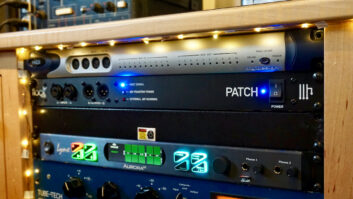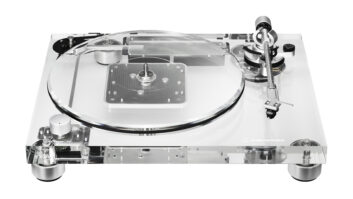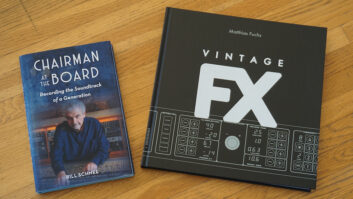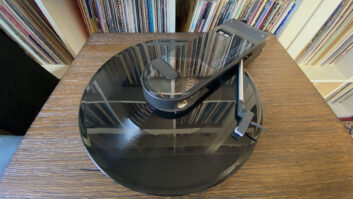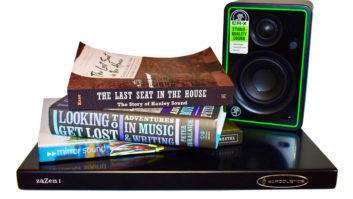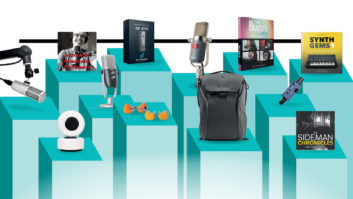The holiday season is once again upon us. Below I share a few hints for what might make an ideal gift for your favorite engineer or producer (or even yourself).
Audient iD4
Audient has a history of making great gear and when accepting the task of designing and building a low-cost I/O, it came up with the iD4 ($195). The iD4 provides 96 kHz/24-bit operation, is housed in a rugged aluminum chassis and connects to a computer via USB 2. Audient chose to feature two inputs—a single, high-quality mic pre and a single high-quality DI—instead of two or four compromised dual mic-pre/DI inputs. The bus-powered iD4 is quite possibly the perfect mobile I/O as it utilizes the same mic preamp used in Audient’s flagship ASP 8024 and a classic valve amp-inspired JFET DI.
The iD4 incorporates balanced stereo outputs via quarter-inch jacks and a wonderful-sounding dual output (one via 3.5 mm mini-jack and one via quarter-inch jack) Class-AB headphone amp. The box incorporates ScrollControl, Monitor Mix and Monitor Pan functions. ScrollControl converts the volume control into a virtual scroll wheel, allowing easy, mouse-free plug-in parameter adjustment. Monitor Mix is a direct monitoring function that allows both iD4 inputs to be blended with the DAW output for near-zero latency monitoring while recording. Monitor Pan allows the inputs to be panned in the monitor signal path, simplifying the creation of a well-balanced headphone mix when simultaneously recording both inputs. This is impressive functionality for a box that clocks in under $200. I’ve been using the iD4 regularly for several months and I’m thoroughly impressed with its performance. While it’s the perfect mobile demo rig, I wouldn’t hesitate to use either the mic pre or the DI on a sonically critical master project.
Auralex MudGuard v2
The Auralex MudGuard v2 ($169) is a microphone isolation shield that drastically reduces external noise bleed while filtering out unwanted acoustic reflections. The device measures 16 inches wide by 10 inches deep by 14 inches high, and mounts on any mic stand either separate from the microphone or sharing a stand with the microphone using the included hardware. The idea behind the MudGuard v2’s shape is that its proprietary “multi-radii” design diverts internal shell reflections away from the microphone. Auralex claims concave and parabolic shaped surfaces result in reflections being reflected back towards the microphone rather than away from it, but the MudGuard v2 either absorbs incoming noise and room tone or reflects it away.
I have used the MudGuard v2 while recording vocals, acoustic guitar and electric guitar cabinets over the past several months and it has made a significant sonic improvement to my recordings.
Book: Sound Explosion!: Inside L.A.’s Studio Factory with the Wrecking Crew
There’s nothing better than sitting down with a good book over the holiday season and there are a couple of recent releases that can’t be missed. First, of all, Ken Sharp’s Sound Explosion!: Inside L.A.’s Studio Factory with the Wrecking Crew ($45 for soft cover, $100 for hard cover) is one of the best coffee table books I’ve encountered. A perfect companion to 2015’s award-winning The Wrecking Crew documentary, this fabulous book includes an inside look into the elite group of musicians that formed the musical backbone for hundreds of legendary recordings from the ‘60’s and ‘70s.
It features exclusive interviews with dozens of artists, producers and musicians, including the Beach Boys, Cher, the Monkees, the Mamas & the Papas, the Carpenters and Herb Alpert. It also includes behind-the-scenes stories of the making of more than 50 of the Wrecking Crew’s top tracks, including “You’ve Lost That Lovin’ Feeling,” “Good Vibrations,” “I Got You Babe,” “California Dreamin’,” “Mr. Tambourine Man,” “Last Train to Clarksville,” “Wichita Lineman,” “Bridge Over Troubled Water” and “ABC.” The hundreds of photos provide additional insight into many of these recordings.
Book: Mixerman and the Billionheir Apparent
Legendary Mixerman (aka Eric Sarafin) has released his next book, Mixerman and the Billionheir Apparent ($24.99), and it’s another grand slam. The satirical novel takes a humorous, albeit grim, look at the collapsing music industry as it uncovers the widening economic division between music creators and their distributors. Mixerman has the unique talent of being able to share tremendous wisdom and deep truth while simultaneously being entertaining and hilarious. The sad news is that Mixerman is right, as it’s nearly impossible for an independent artist to break a song on the Internet. That said, I’ve never gained so much insight while laughing my head off. Don’t miss it and if you’ve never read a Mixerman book, check them all out. They’re well worth your time.
IK Multimedia iRig Keys Mini
The iRig Keys Mini ($79.99) is a two-octave MIDI keyboard that directly connects to an iPhone, iPad, Android device or laptop computer. A driver has to be installed for computer connectivity but iOS and Android operation are plug and play. The keyboard is bus-powered so battery charging or replacement isn’t a consideration. While it looks good alongside any device, its width is almost identical to that of the iPad Pro, making the perfect mobile rig when the two are coupled together.
The iRig Keys includes Lightning, OTG to Micro-USB, and USB cables. Connecting to an older iOS device requires the purchase of a 30-pin cable. The Core MIDI and USB class compliant keyboard incorporates 15 white and 10 black smaller than normal yet completely playable keys, an assignable Volume/Data knob, and back-lit, soft-touch Octave Up/Down buttons that make it quick and easy to make the device land on the desired octave.
Although built of plastic, the iRig Keys Mini feels robust and well made. I’ve been using mine for nearly a year and it’s never failed. And while I’d feel more comfortable if it included a protective slipcase, mine still looks new.
MXL DX-2 Microphone
The MXL DX-2 ($149.95) is a dual-capsule dynamic microphone that allows the sound of the mic to be varied by blending between the two capsules. The side-address mic’s forte is electric guitars and, since the front of the mic is physically flat, it is easy to drape it over a guitar cabinet and perfectly position in the desired location while hanging from the mic cable. It also includes a stand mount, making it easy to use on snare drum, percussion, kick drum, etcetera (I’ve successfully used it in all of these instances.).
The blend knob is on the rear side of the mic, making for easy access. The capsules both sound good yet are drastically different. Capsule 1 is a warm, smooth, large-diaphragm super cardioid capsule and Capsule 2 is a sparkling, clean, small-diaphragm cardioid capsule. The two capsules perfectly compliment each other. If you want a bigger, thicker, beefier sound, blend in more of Capsule 1. If you want more top, attack or bite, blend in more of Capsule 2. The precise positioning of the capsules within the enclosure eliminates phase issues between the two capsules, making setup quick and easy. The only thing that would make this mic better is if you could control the blend in the control room with out having to go to the mic. I guess that’s why we have assistants, right?
Ultimate Ears Microsonic Earplugs
Ear protection should be a top concern for every engineer, producer and musician because exposure to loud volumes over time damages hearing forever. Ultimate Ears’ Microsonic Earplugs ($199) solve the problem by offering custom-fit earplugs that are made from the same scan as their high-end IEMs. These earplugs reduce all frequencies evenly so rather than creating a muffled sound, they create the impression of simply turning down the volume.
I go to a lot of live shows and you’ll never see me at one without my Microsonic Earplugs. Cymbals still shimmer, vocals retain their clarity, acoustic guitars still sparkle, yet the entire mix is either 9 dB, 15 dB or 25 dB quieter, depending on which interchangeable filter is being used (in my case, it’s 15 dB). The earplugs come with your choice of filter and you have the option of purchasing other filters ($70/pair). Not only do the Microsonic Earplugs work well, they are amazingly comfortable. There have been several instances where I’ve worn them for several hours at a time and they’ve never become irritating.
Waves Nx Virtual Mix Room over Headphones
Gifting a plug-in is never a bad idea, and the Waves Nx Virtual Mix Room over Headphones ($99) is the perfect option. If you aren’t aware of what Waves Nx has to offer, you need to check it out now as it has the potential to become one of the most important audio innovations of the decade. Nx is essentially VR for audio and it’s amazing.
Nx Virtual Mix Room over Headphones is a virtual monitoring plug-in that replicates the acoustics of a professional mix room (stereo or surround) inside your headphones when inserted on the stereo bus (it needs to be bypassed when printing the mix). It works hand-in-hand with the Nx Head Tracker ($79), which is a small device that operates on a single AAA battery and straps to the top of any pair of headphones. While the Head Tracker isn’t necessary, it greatly improves the performance of the Nx 3D audio experience by tracking even the most subtle head movements. I never choose to mix on headphones but occasionally I have to, and I’ve found that I’m able to work faster and obtain better results when utilizing Nx. It makes mixing with headphones more enjoyable, too!
There is also a PC/Mac version ($9.99) and an iOS/Android mobile version (free) that provides the same 3D audio experience to gaming and movies.
